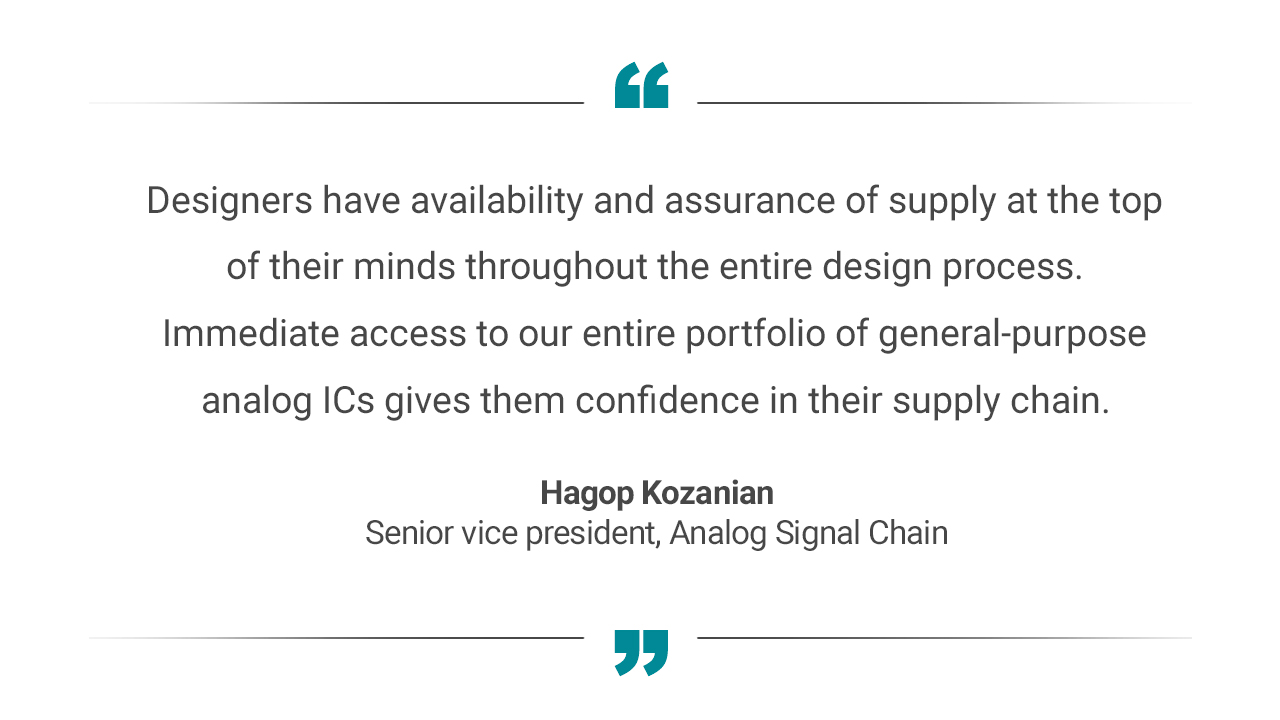The leader of our Analog Signal Chain business discusses how general-purpose analog ICs are crucial for electronic designs

Analog is everywhere. In the world of electronics, analog technology enables applications to operate in the real world by converting voltage levels, sensing, or precisely measuring or conditioning signals. Analog chips are the essential components of every electronics system, from the smallest hearing aid to a data center’s power-supply system.
These essential analog semiconductors – sometimes referred to as foundational or general-purpose integrated circuits (ICs) – comprise a majority of the chips used in an electronic system. Amplifiers, data converters, logic devices and switching regulators may not be the trendiest components on a board, but they are necessary for the system to function, and help enable the electronics innovation we experience today.
As electrification continues to accelerate, research firm Omdia reports that the general-purpose analog IC market continues to expand and is expected to surpass $40 billion by 2027.
Hagop Kozanian, senior vice president of the Analog Signal Chain business unit at our company, recently discussed the factors driving the expansion of general-purpose analog and our continued investment in those critical products.
Q: Why are general-purpose analog products so essential for system designs?
A: We hear a lot about the importance of having a large portfolio of production-ready, general-purpose analog products to meet system requirements. For example, it’s not unusual for an automotive manufacturer to need hundreds of general-purpose analog products in an electric vehicle, sometimes making up nearly 90% of the ICs in an electronic system.
Our teams of engineers work across more than 20 functional categories in power management, signal-chain and logic product areas to develop analog products optimized for the right mix of cost, performance, power and precision our customers need for their designs. Immediate access to these types of chips significantly speeds time to market for existing designs, and provides greater flexibility to scale design options for the future.
It’s important that they know that all of these analog products will work together to meet the system requirements for their designs.

Q: What are the top considerations for engineers when choosing general-purpose analog products?
A: General-purpose analog products are designed to be just that – products that can meet reliability and performance requirements for many different systems. However, I frequently see five main considerations for companies when designing with these products:
- Availability: Designers have availability and assurance of supply at the top of their minds throughout the entire design process. Immediate access to our entire portfolio of general-purpose analog ICs gives them confidence in their supply chain. We provide a real-time view of available inventory on TI.com, instant-access tools for order management, and APIs to directly connect their order management systems with ours.
- Pricing: Engineers want to create more affordable electronics using analog products that are optimized for size, cost and performance. Our goal is to provide reliable general-purpose analog products at an affordable price, and we regularly monitor pricing to remain competitive, although we already have the advantage of a lower cost structure because of our company’s internal 300mm manufacturing capacity.
- Standard analog packaging: Designers need a wide array of package options, including standard, surface-mount pin-to-pin packages such as small outline no-lead (SON), small outline transistor (SOT) or thin-shrink small outline package (TSSOP) to fulfill their multisource design implementations. We provide the broadest portfolio of industry-standard packages and innovative package types such as our HotRod™ package to solve design challenges such as solution size, reliability and thermal performance requirements.
- Longevity and reliability: Designers ultimately want to know that they have access to quality, reliable products. We continue to invest in intellectual property and manufacturing capacity using 45nm to 130nm process nodes to build general-purpose analog products that help ease design complexity and provide supply assurance. In fact, owning and operating wafer fabrication, packaging, assembly and test, and product distribution facilities around the globe gives our company control of the supply chain to provide reliable analog products for decades.
- Documentation and resources: Designing with analog products should be as easy as possible with the right resources. Our analog experts work continuously to develop resources so that companies can quickly prototype their designs using advanced simulation models. Combined with thousands of technical documents, available circuits and reference designs, our goal is to help speed time to market.
Q: What role will TI play in the future of general-purpose analog products?
A: Over the past two decades, we have expanded our extensive analog portfolio to include thousands of general-purpose ICs across power, signal-chain and logic product areas. Our experts and investment in research and development allow us to introduce hundreds of new products every year. And our ability to scale quickly with alternative and second-source analog products helps us reduce supply-chain interruptions in a significant way.
Analog technology will continue to be essential to help engineers innovate and add electrification to their products for many years to come.


